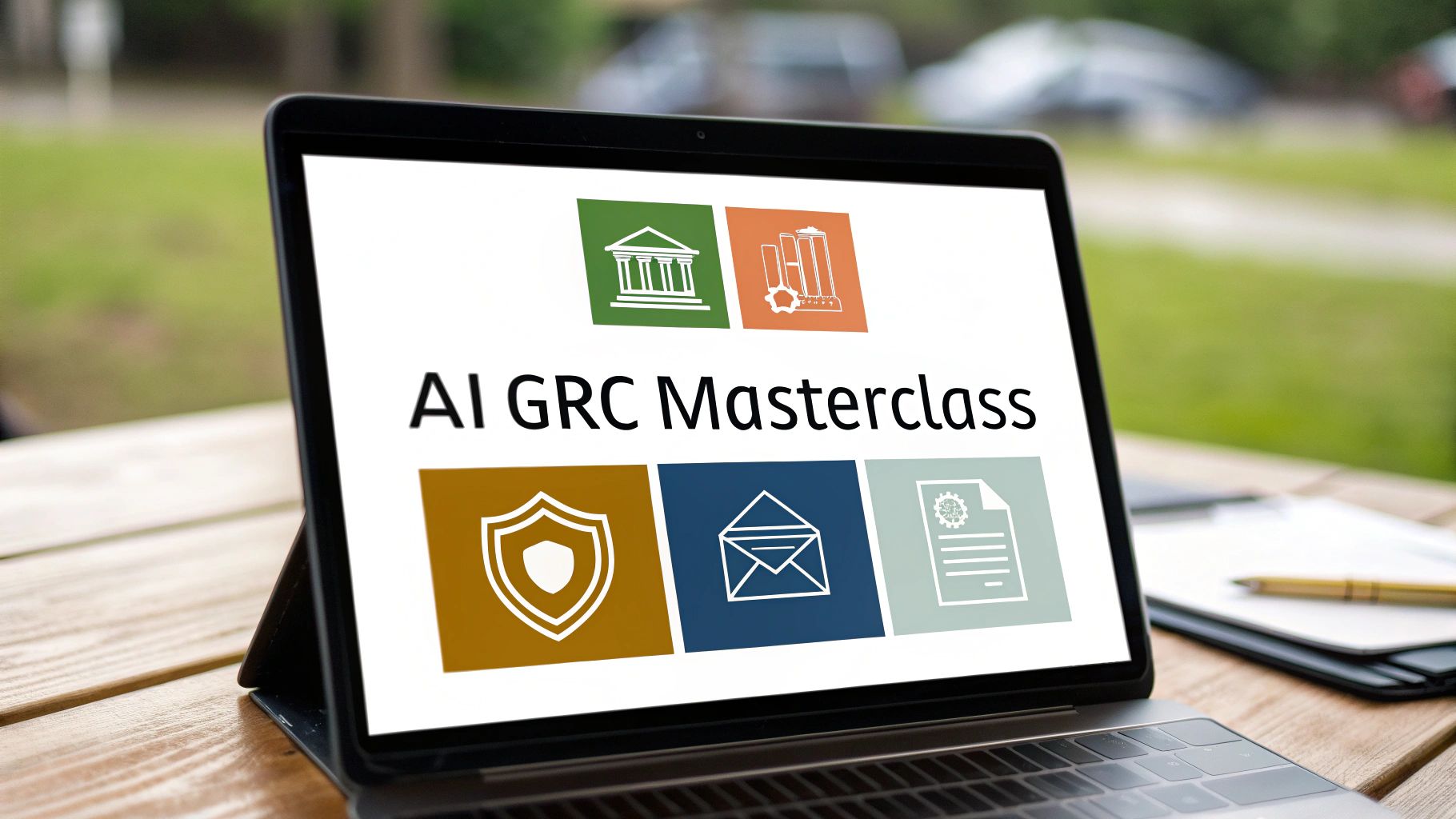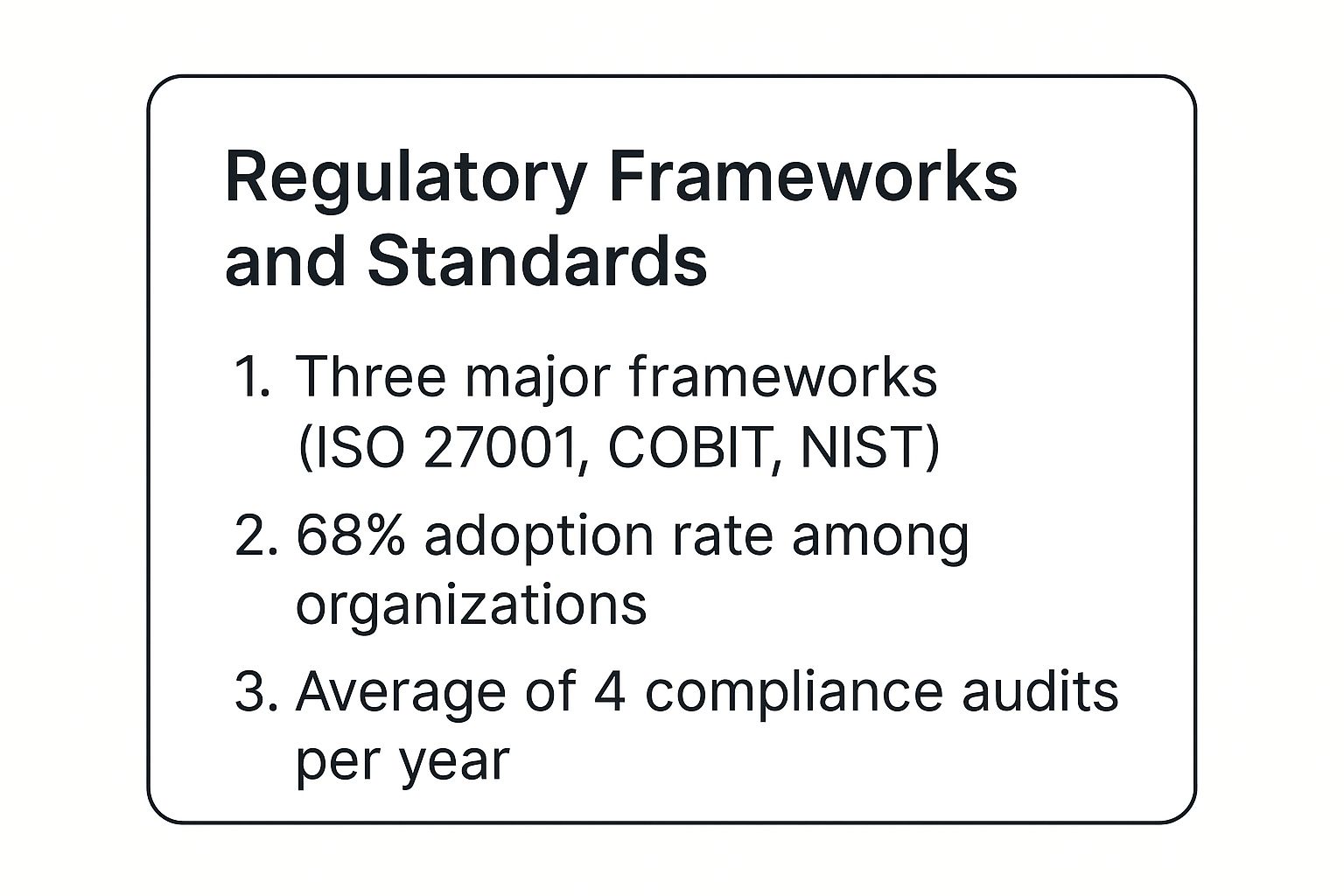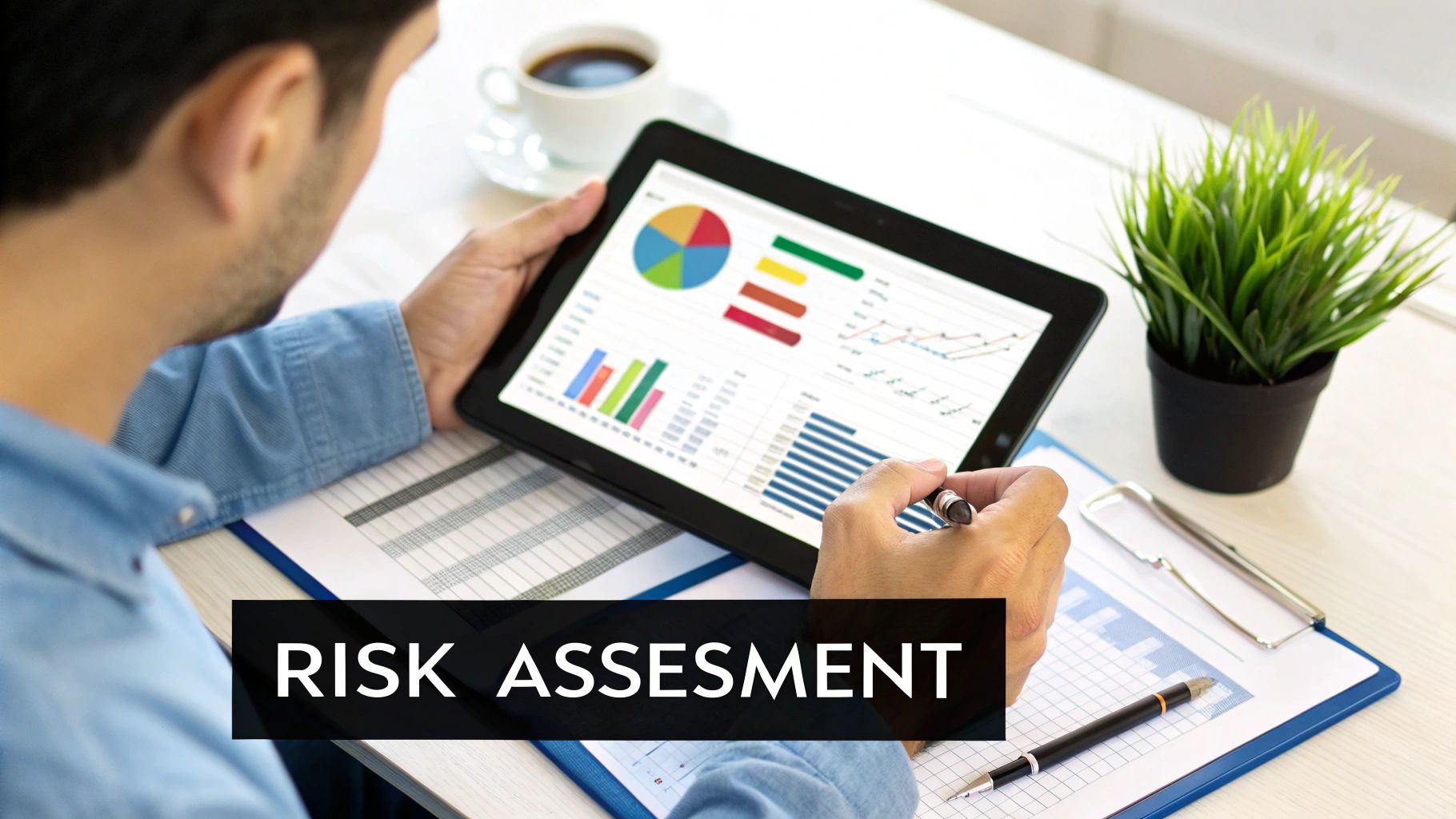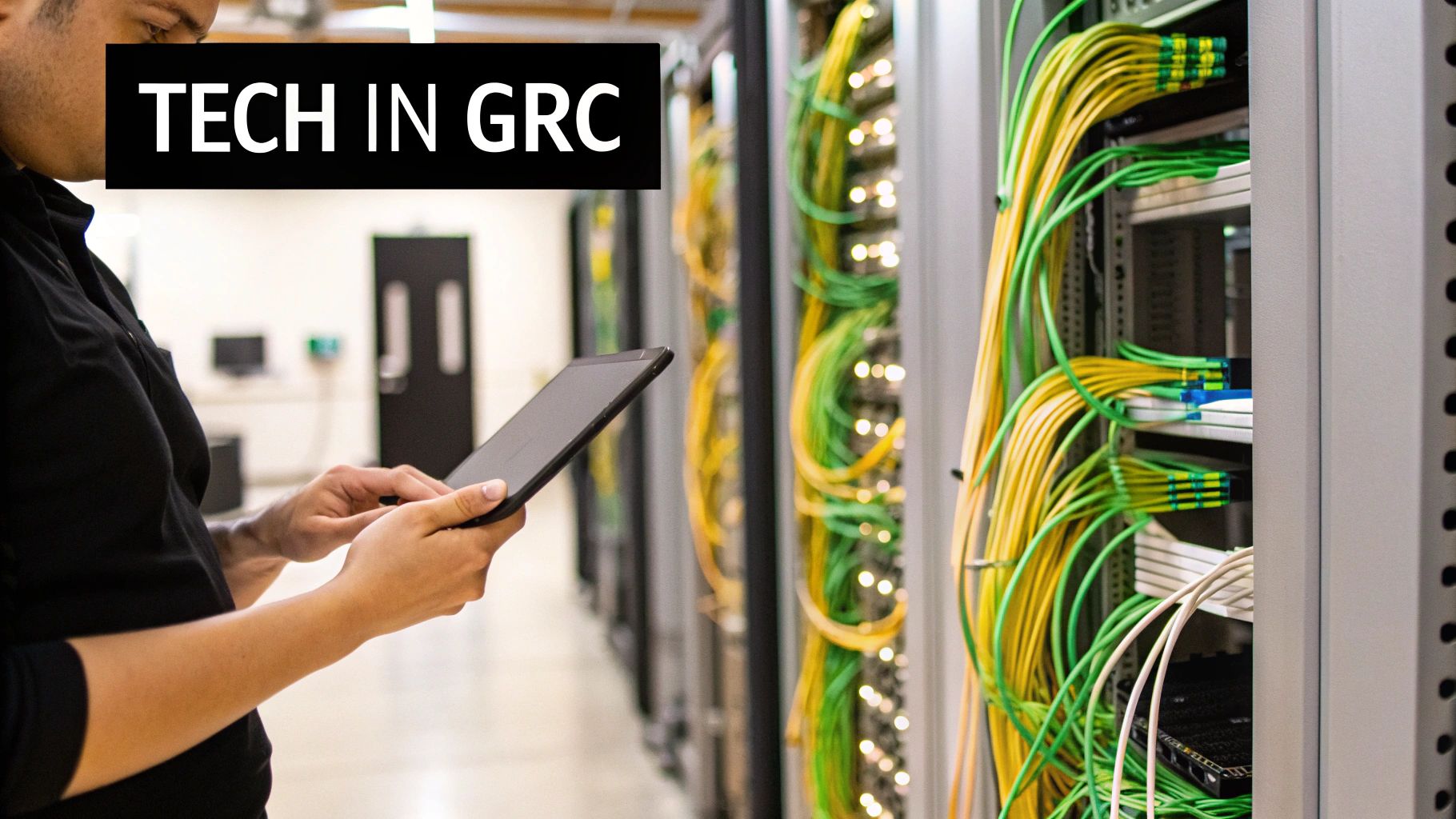
AI Governance Compliance and Risk Masterclass
Welcome to a new reality where governance, compliance, and risk for artificial intelligence isn't just a footnote—it's the main headline. With the European Union's AI Act setting a global benchmark, a solid GRC (Governance, Risk, and Compliance) framework has become an absolute necessity for any company using AI. This is all about laying the groundwork for trustworthy AI that can not only survive but thrive under these new rules.
The New Reality of AI Governance, Compliance, and Risk

The EU AI Act represents a massive shift in thinking. Not long ago, AI development was often a "wild west" affair, happening in isolated labs with little to no oversight. Now, any organization developing or using AI systems that affect EU citizens must play by a strict set of rules. The penalties for getting it wrong are steep, with fines reaching up to €35 million or 7% of a company's global annual turnover.
This regulatory push forces businesses to embed governance, compliance, and risk management into every stage of the AI lifecycle. It’s no longer enough to just build a powerful algorithm; you have to prove it’s safe, fair, and transparent from the get-go. That requires a complete rethink of how teams innovate.
The GRC Trinity for AI Success
To really get a handle on this, it helps to break GRC down into its three core pillars, especially as they relate to the EU AI Act. Think of it like building a self-driving car—each component is critical for a safe and successful ride.
- Governance: This is your AI’s core operating system. It sets out who is accountable for AI systems, the policies they need to follow, and the procedures for building, deploying, and keeping an eye on them.
- Compliance: These are the traffic laws and safety regulations. For AI, this means ticking all the legal boxes in the EU AI Act, from ensuring data quality to keeping meticulous records.
- Risk: This is the car's ability to see and react to hazards on the road. It’s all about spotting, evaluating, and neutralizing potential harms your AI could cause, like discriminatory outcomes or security weak spots.
When you weave these three elements together, you don't just get a powerful system; you get a trustworthy one.
The EU AI Act isn’t just another legal hurdle; it’s a blueprint for building responsible AI. Companies that master AI governance, compliance, and risk won’t just dodge fines—they’ll build deeper trust with their customers.
This guide is designed to give you a practical path through the complexities of the EU AI Act. We’ll help you move beyond a simple box-checking mentality and show you how to turn these regulatory duties into a real competitive edge. The focus here is on actionable steps, from figuring out your AI's risk level to setting up continuous monitoring, so you can build your innovations on a rock-solid foundation of safety and accountability.
Getting to Grips With the EU AI Act's Risk-Based Framework
At its core, the EU AI Act is built on a surprisingly practical idea: not all AI is created equal. The regulation uses a risk-based approach, which means the level of regulatory scrutiny directly matches the potential for an AI system to cause harm. This tiered system focuses the strictest rules where they matter most, ensuring your governance, compliance, and risk management efforts are proportional and effective.
Think of it like vehicle safety standards. A family minivan and a Formula 1 race car are both "vehicles," but they're governed by wildly different rules because their contexts and potential for public harm are worlds apart. The EU AI Act applies the same logic, sorting AI systems into clear categories based on their potential impact on our safety, health, and fundamental rights.
This classification is the first—and most critical—step in your compliance journey. Why? Because it determines the exact set of obligations your organization must meet. Getting this classification wrong can lead to wasted resources, or far worse, major non-compliance penalties down the line.
The Four Tiers of AI Risk
The EU AI Act sorts AI systems into four distinct tiers, each with its own rulebook. This structure is designed to help businesses understand their specific governance, compliance, and risk duties without getting bogged down by a one-size-fits-all mandate.
Let's break them down:
Unacceptable Risk (Banned): These are the no-gos. AI systems in this category are seen as a clear threat to human safety and rights and are simply banned. Think of government-run social scoring systems or AI that psychologically manipulates people into harmful actions.
High-Risk (Strictly Regulated): This is where the real work begins for many companies. High-risk AI is permitted but faces a mountain of strict requirements. This includes AI used in critical infrastructure (like energy grids), medical devices, or in hiring and recruitment. These systems demand robust governance and continuous risk management before and after they hit the market.
Limited Risk (Transparency Required): For these systems, the name of the game is transparency. Users must know they are interacting with an AI. This covers things like chatbots and deepfakes. The key obligation is clear disclosure—no one should be tricked into thinking they're talking to a person or viewing real media.
Minimal or No Risk (Generally Safe): This is the biggest bucket, covering the vast majority of AI in use today, like spam filters or recommendation engines in video games. These systems are considered safe and face no specific legal obligations under the EU AI Act, though adopting voluntary codes of conduct is still a good practice.
This visual gives you an idea of the kinds of frameworks organizations are already using to manage complex regulatory demands.

The high adoption rate and frequent audits highlight just how vital established frameworks are for navigating dense regulations like the EU AI Act.
Here's a quick summary of how these risk tiers translate into GRC actions.
EU AI Act Risk Tiers and GRC Implications
This table breaks down the EU AI Act's risk categories and what they mean for your governance, compliance, and risk management strategy.
| Risk Tier | Description & Examples | Primary GRC Obligation |
|---|---|---|
| Unacceptable | AI systems posing a clear threat to safety, livelihoods, and rights. Examples: Social scoring, manipulative AI. | Prohibition. The main task is to identify and ensure these systems are not developed, deployed, or used. |
| High-Risk | AI with significant potential to harm health, safety, or fundamental rights. Examples: Medical devices, AI in recruitment. | Full-Scale Compliance. Requires a robust risk management system, data governance, technical documentation, human oversight, and conformity assessments. |
| Limited Risk | AI where the main risk is a lack of transparency. Examples: Chatbots, deepfakes. | Transparency. Users must be clearly informed they are interacting with an AI system. |
| Minimal Risk | AI with little to no risk. Examples: Spam filters, AI-enabled video games. | No mandatory obligations. Voluntary codes of conduct are encouraged to build trust. |
Understanding where your AI system lands is the foundational step that informs every subsequent GRC decision you'll make.
A Deeper Look at High-Risk AI Obligations
For most organizations developing or deploying serious AI tools, the high-risk category is where the rubber meets the road. Compliance here isn't a one-and-done checkbox; it demands a continuous cycle of governance and risk management.
If your AI is classified as high-risk, you'll need to establish a comprehensive quality management system, maintain meticulous technical documentation, prove your datasets are high-quality and free of bias, and build in mechanisms for human oversight. These aren't just best practices—they are legally mandated requirements under the EU AI Act.
To get into the weeds on these rules, you can learn more about the EU Artificial Intelligence Act in our detailed guide.
The central idea for the high-risk category is accountability. You must be ready to prove—at any given moment—that your AI system is safe, transparent, and fair throughout its entire lifecycle.
For example, imagine a company building an AI-powered tool for screening job applicants. As a high-risk system, they would need to painstakingly document their algorithms, the data used to train the model, and all the steps taken to test for and mitigate bias. They'd also need a "human-in-the-loop" feature, allowing a recruiter to review and override the AI's suggestions. This is how the EU AI Act’s legal text translates into real-world actions that create a trustworthy and compliant product.
Building a Resilient AI Governance Structure

Managing AI governance, compliance, and risk effectively doesn’t just happen. It’s the result of a deliberate, well-designed structure. Think of it like creating a constitution for your company's AI efforts. Without clear rules, defined roles, and established processes, you're essentially operating in chaos—a very dangerous place to be, especially with the EU AI Act looming.
A solid AI governance framework acts as the central nervous system for everything you do with AI. It’s what connects your tech teams with legal, compliance, and the C-suite, making sure everyone is working from the same playbook. This structure is what turns abstract regulatory principles into concrete, everyday actions that people can actually follow.
Establishing Clear Lines of Authority
First things first: you have to define who is responsible for what. When it comes to EU AI Act compliance, ambiguity is your worst enemy. To build real clarity and accountability, you need to establish specific roles and committees tasked with AI oversight.
This usually means creating a few new roles or expanding existing ones:
- Chief AI Officer (CAIO): This is the senior leader who owns the company's entire AI strategy, including the crucial ethical and compliance angles.
- AI Review Board: Think of this as a cross-functional team of experts—legal, tech, ethics, and business—who must review and sign off on high-risk AI projects before they get the green light.
- AI Ethics Committee: This group focuses squarely on the ethical side of things, ensuring your AI systems align with both your company's values and broader societal expectations.
By putting these roles in place, you create clear points of contact and decision-makers. It’s absolutely critical for managing the AI lifecycle from start to finish and ensures no AI system gets developed in a silo. Oversight is baked in from the very beginning.
Crafting Practical AI Policies and Procedures
Once you have the right people in charge, you need to give them the rules of the road. Your AI governance structure needs to be backed up by practical, easy-to-understand policies that actually guide your developers and data scientists. These aren’t just stuffy legal documents; they're actionable playbooks.
Your key policies should cover a few core areas mandated by the EU AI Act:
- Data Governance: How you collect, store, and use data to train AI models, with a heavy emphasis on privacy and rooting out bias.
- Model Development and Validation: The specific standards and testing protocols an AI model has to pass before it ever sees the light of day, especially for high-risk systems.
- Transparency and Explainability: The level of documentation required to explain how an AI model arrives at its decisions, which is a non-negotiable requirement under the EU AI Act.
This is where data security really takes center stage. In fact, cybersecurity and data privacy are the top compliance risks for organizations all over the world. According to PwC’s 2025 Global Compliance Survey, a staggering 51% of executives rank cybersecurity and data protection as their highest compliance concerns. You can dive deeper into the findings in the PwC Global Compliance Study.
Embedding Accountability at Every Stage
A strong governance structure isn’t just about making rules; it’s about creating a culture of responsibility. Accountability has to be woven into the very fabric of your AI development process, from the first brainstorm all the way to post-market monitoring.
The ultimate goal of AI governance is to make responsible development the default, not an afterthought. This means building systems and processes where the easiest path is also the most compliant and ethical one.
This is formalized through mandatory processes like the conformity assessments required for high-risk AI. This is basically an internal audit where you prove to regulators that your AI system meets all the safety, transparency, and data quality standards demanded by the EU AI Act. The process forces teams to document their work meticulously and validate their claims, creating an undeniable paper trail.
In the end, a resilient governance structure does more than just keep you out of trouble. It builds trust with your customers, empowers your teams to innovate safely, and turns the complex demands of governance, compliance, and risk into a real, sustainable competitive advantage.
Staying Ahead: Embedding Continuous AI Compliance and Monitoring
Getting your AI system compliant with the EU AI Act isn't a one-and-done task you can check off a list. Think of it more like keeping a high-performance car in top shape. You wouldn't just drive it off the lot and never think about maintenance again, right? It needs regular oil changes, tire rotations, and system checks to run safely. AI systems are no different. They require constant oversight after deployment to make sure they're still performing as expected and managing risk.
This ongoing process has a name: post-market monitoring. It's a non-negotiable requirement for high-risk AI under the EU AI Act, designed to actively track how a system behaves once it's out in the real world. You can't just launch your AI and hope for the best. This monitoring is the very heart of a living governance, compliance, and risk program.
The Core of Post-Market Monitoring
So, what does "monitoring" actually mean here? It's much more than just watching for error messages or technical glitches. It’s a systematic plan for collecting and analyzing data on your AI's performance, always on the lookout for any unexpected behavior or new risks popping up. Being proactive means you can spot and fix problems before they snowball into major compliance headaches.
The EU AI Act is quite specific about what this system needs to include:
- Robust Logging: Your AI must keep a detailed diary of its operations, its decisions, and the data it's using. This creates a bulletproof audit trail, which is absolutely essential when you need to figure out why the AI did what it did, especially during an incident investigation.
- Incident Reporting: You need clear, accessible channels for users and others to flag problems. If a serious incident happens, you have strict obligations to notify national authorities. A messy reporting process just won't cut it.
- Vulnerability Management: Like any piece of software, AI systems can have security weaknesses. A core part of continuous monitoring is actively scanning for these vulnerabilities and patching them up before they can be exploited.
Conducting Regular Risk Assessments
All the data you gather from post-market monitoring feeds directly into a cycle of regular risk assessments. These aren't just for the tech team. They have to look at the bigger picture, considering the ethical and societal impacts your AI has as it operates in the wild.
For instance, an AI tool for loan approvals might be technically flawless, but over time it could start showing a bias against a certain demographic because the input data has subtly changed. A continuous risk assessment process is designed to catch exactly this kind of "performance drift" before it causes real harm.
An effective monitoring strategy treats EU AI Act compliance not as a static goal, but as a living process. It’s about building a feedback loop where real-world performance data constantly informs and sharpens your risk management framework.
This dynamic approach is crucial. A global survey of compliance leaders revealed that 85% feel regulatory requirements have gotten more complex over the past three years. This isn't just an annoyance; 82% of businesses said this complexity hurt their ability to innovate and make changes. A well-oiled monitoring process helps you cut through that complexity, letting you stay agile without cutting corners on compliance.
How ComplyAct AI Keeps You Continuously Compliant
Trying to manage all this post-market monitoring by hand is a recipe for burnout and human error. It’s a massive undertaking. This is where a platform like ComplyAct AI becomes a game-changer, automating the heavy lifting and turning a tedious chore into a strategic advantage.
The platform gives you a central dashboard to see your AI's performance and compliance status in real-time. It sends out automated alerts for potential red flags, like model drift or data anomalies, so your team can jump on issues right away. By generating audit-ready reports and keeping a complete log of all monitoring activities, ComplyAct AI ensures you’re always prepared to show regulators your due diligence. It turns the marathon of continuous monitoring into a manageable part of your everyday governance, compliance, and risk strategy.
Using Technology to Automate AI GRC
Trying to manage AI governance, compliance, and risk manually is a recipe for disaster, especially with the EU AI Act looming. Think of it like trying to fly a modern jetliner with nothing but a paper map and a compass. You might get off the ground, but you’re courting catastrophe. The complexity of the machine demands an advanced cockpit with real-time data and automated systems.
That’s exactly what’s happening with AI GRC. Relying on spreadsheets and scattered documents just won’t cut it. The dynamic nature of AI systems and the strict documentation rules of the EU AI Act demand a better approach. A purpose-built GRC platform is your advanced cockpit, automating the grunt work and giving you a single, clear view of your entire AI landscape.
The Power of a Centralized GRC Platform
The biggest win from using a dedicated tech solution is creating a single source of truth. No more digging through different department folders for risk assessments, data policies, or conformity documents. Everything lives in one place, which is a lifesaver for internal oversight and being ready for an audit.
These platforms automate several key tasks mandated by the EU AI Act:
- Documentation Generation: Guided wizards walk your teams through creating the hefty technical documentation for high-risk AI, making sure nothing slips through the cracks.
- Continuous Monitoring: They keep an eye on your models 24/7, automatically flagging things like model drift, performance drops, or new biases before they become serious compliance headaches.
- Risk Management Workflows: They bring consistency to how you find, assess, and deal with risks, building a clear and defensible audit trail along the way.
This isn't just a nice-to-have; it's a strategic imperative. A recent PwC survey found that 82% of companies are planning to spend more on compliance technology. And according to another report, 71% of leaders believe AI will actually help their compliance functions, showing a clear shift toward smarter, automated GRC. You can dig into more stats in the 2025 Global Compliance Survey findings.
From Reactive Checklists to Proactive Oversight
Automation flips your GRC strategy from reactive to proactive. Instead of frantically pulling documents together for an audit, you live in a state of constant readiness. A centralized platform gives leadership a clean, real-time dashboard of the company’s AI risk profile. That kind of visibility is gold for making smart decisions and proving to regulators that you’re doing your homework.
With automation, governance, compliance, and risk management stops being a frustrating administrative burden. It becomes a core business function that actually supports safe and responsible innovation.
Platforms like ComplyAct AI are designed from the ground up to do just this. They take the dense legal text of the EU AI Act and turn it into practical, automated workflows—from classifying risk at the start to spitting out audit-ready reports at the end. This approach not only slashes the risk of human error but also frees up your best people to build great products instead of drowning in paperwork. If you're curious about what to look for in these tools, check out our guide on choosing the right software for compliance. By picking the right technology, you can build a solid GRC framework that grows with your AI ambitions and keeps you prepared for whatever regulators throw your way.
Getting AI Act Ready—And Staying That Way

Tackling the EU AI Act isn’t just about ticking a few legal boxes. It’s a complete strategic mission. This means shifting your entire company mindset from a reactive, checklist-driven approach to a proactive culture of genuine accountability and constant improvement. The goal is to weave responsibility directly into the DNA of your AI development process, from the first line of code to the final deployment.
By getting to grips with the EU AI Act's risk-based structure, you can channel your efforts where they'll have the most impact—placing the tightest controls on your high-risk systems. A solid governance framework with clearly defined roles and sensible policies turns good intentions into consistent, everyday actions. From there, continuous monitoring and the right automation tools can transform compliance from a one-off project into a living, breathing part of your operations.
The Real Goal: Building Trustworthy AI
The destination here isn’t just compliance. It's about building AI that is fundamentally trustworthy, reliable, and genuinely innovative. When you get this right, a regulatory headache becomes a serious market advantage. Companies that fully commit to a strong governance, compliance, and risk (GRC) mindset today aren't just dodging fines; they're positioning themselves to lead their industries tomorrow.
Sustainable readiness for the EU AI Act is all about building an ecosystem where the easiest path for your teams is also the most compliant and ethical one. That’s how you create resilience and spark real innovation.
Of course, for many businesses, this is made even trickier by the web of existing compliance regulations by industry, each with its own quirks. The secret is to integrate these various demands under a single, unified GRC umbrella.
How Regulation Can Give You a Competitive Edge
At the end of the day, the principles baked into the EU AI Act are more than just legal requirements—they're a recipe for building better AI. By making fairness, transparency, and human oversight top priorities, you build unshakeable trust with your customers and partners.
This forward-thinking stance on governance, compliance, and risk does more than just shield your organization from penalties; it elevates your brand. It sends a clear signal to the market that you're a responsible innovator, poised to lead in an age where trustworthy AI is the ultimate competitive advantage. You’re not just preparing for a new law; you’re preparing for a future where responsible technology is simply the price of admission.
Frequently Asked Questions
When you're dealing with something as new and impactful as the EU AI Act, questions are bound to come up. It's a new landscape for everyone, and a lot of companies are wondering where to even begin. Here are some of the most common questions we hear from organizations trying to get their AI governance, compliance, and risk management in order.
Where Do We Even Start with EU AI Act Compliance?
That feeling of being overwhelmed is normal, but the first few steps are pretty straightforward. Before you can manage anything, you need to know what you have.
The first move is to create a complete inventory of every AI system you're using. This isn't just about the models your teams are building; it also includes any third-party AI tools you've deployed. Once you have that list, you can do an initial risk classification for each one according to the EU AI Act's categories. This immediately shows you which systems are considered high-risk and need your full attention right away.
With that map in hand, pull together a dedicated governance team. You'll want people from legal, IT, data science, and the business side of the house. Getting all those perspectives in one room from the start is the only way to build a truly solid oversight strategy.
We're Not Based in the EU. Does the EU AI Act Still Affect Us?
Yes, there's a very good chance it does. The EU AI Act has what's called extraterritorial scope, meaning its rules can apply to companies well outside of Europe's borders.
This is a wake-up call for many global businesses. If you offer an AI system and its output is used in the EU market, you're on the hook. It doesn't matter where your headquarters are. Think of a US-based software company that sells an AI-powered hiring platform to a firm in Germany. That US company has to follow the EU AI Act's rules for high-risk systems to the letter.
The thing to remember is that the law follows the AI's impact, not the company's location. If your AI has a footprint in the EU, you have to comply.
How Can We Handle All the Documentation for High-Risk AI Without Going Crazy?
Trying to manage the documentation for a high-risk AI system with spreadsheets is a recipe for disaster. The requirements are just too deep. The key is to stop thinking of documentation as a final step and start building it into your process from day one.
The smart approach is to use a central platform where every piece of technical documentation, every risk assessment, and every conformity check lives. This gives you a single source of truth, which is a lifesaver when an auditor comes knocking. Using standardized templates for different documents also helps ensure nothing gets missed.
Even better, bake the documentation right into your development lifecycle. When documenting becomes a natural part of building and testing, it stops being a last-minute fire drill.
What Exactly Is Post-Market Monitoring, and Why Does It Matter So Much?
Post-market monitoring is the official term for a simple idea: you have to keep an eye on your AI system after it’s out in the world. It’s a core part of the EU AI Act because it recognizes that AI governance, compliance, and risk don't end at launch.
This ongoing watchfulness is critical because AI models aren't static. They learn and change based on the data they see. Monitoring helps you catch when a model's performance starts to slip, when it begins to "drift" from its original purpose, or when new biases pop up that weren't there in the lab. It’s how you ensure an AI system stays safe and fair throughout its entire life, protecting your users and your business from nasty surprises.
Ready to turn the headache of AI compliance into a well-oiled machine? ComplyAct AI gives you the toolkit to classify your AI, produce audit-ready documentation, and handle continuous monitoring from a single platform. Get prepared for the EU AI Act—visit ComplyAct AI to see how we can help.